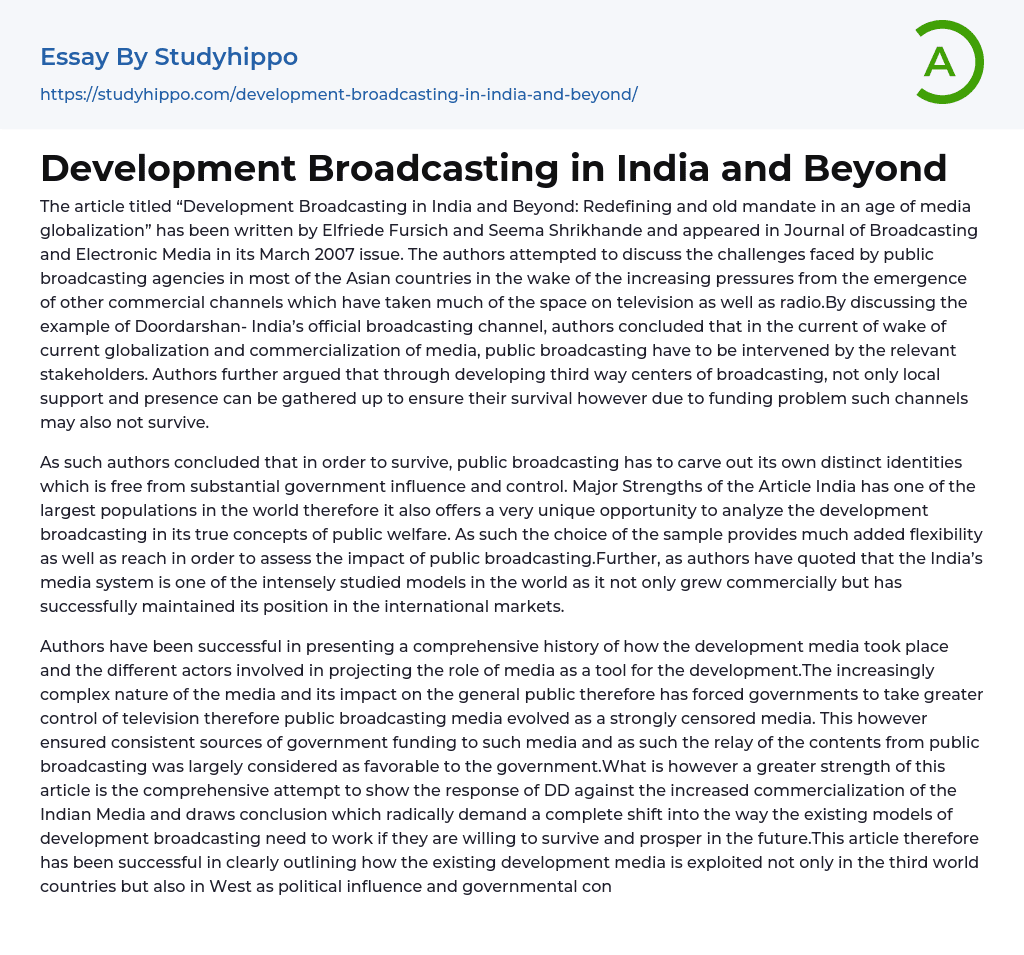

Development Broadcasting in India and Beyond Essay Example
The March 2007 issue of the Journal of Broadcasting and Electronic Media contains an article entitled "Development Broadcasting in India and Beyond: Redefining an Old Mandate in an Age of Media Globalization," authored by Elfriede Fursich and Seema Shrikhande. The article examines the challenges faced by public broadcasting agencies in many Asian countries, given the increased competition from commercial channels on television and radio. The authors use India's official broadcasting channel, Doordarshan, as an example to demonstrate how public broadcasting entities require intervention from relevant stakeholders in the wake of globalization and media commercialization. They also suggest that developing third-way centers of broadcasting could gather local support and presence, ensuring survival; however, funding issues could still pose a threat to such channels' longevity.
According to the authors, public broadcasting must establish its dist
...inct identity that is not significantly influenced or controlled by the government to survive. The article's major strengths lie in the fact that India, with one of the world's largest populations, offers a unique opportunity to examine the development of broadcasting in terms of public welfare. The selected sample also provides added flexibility and reach in assessing the impact of public broadcasting. Furthermore, the authors noted that India's media system is a well-studied model worldwide that has not only experienced commercial growth but also maintained its position in international markets.
The authors have effectively chronicled the history of the development of media and the various individuals and entities involved in advocating for the media's use as a means of promoting development. Due to the media's growing complexity and influence on society, governments have had to exert more authority over television networks, which has led to
the emergence of highly regulated public broadcasting media.The article highlights the favorable relation between consistent government funding and the relay of content from public broadcasting. Additionally, it comprehensively depicts DD's response to the increased commercialization of Indian media and draws radical conclusions about the need for a complete shift in existing models of development broadcasting for future survival and prosperity. The article successfully outlines how political influence and governmental control forces channels to deviate from their mandate, representing the political interests of certain groups. The authors cite cross-border experiments as examples and build a case advocating for the functioning of the developmental broadcasting model under changing socio-political situations.
The authors argue that Western Media's examples prove that the Development media is being pressured by politics and bureaucracy, and deviating from its mandate of educating about development issues. However, the article's major weaknesses include its narrow focus on DD as a case study, despite the fact that education has always been the aim of developmental broadcasting. DD has succeeded in improving government efforts towards development. The authors also failed to address the positive impact of development broadcasting on welfare, instead focusing on how public broadcasting can compete with commercialization.
The authors fail to recognize that programming success relies on consumer perception. If commercial channels do not meet consumers' needs like public broadcasting does, they may switch back to public broadcasting. Therefore, public media should prioritize providing content that fully satisfies viewers instead of excessive innovation. Commercial production often highlights cultural aspects that may not apply to the culture being studied. For instance, programs featuring high nudity in India by MTV may not be well-received due to cultural differences.
While
some consider commercial media as a possible alternative to government-controlled developmental media, its acceptability may not be strong. Additionally, proposing an alternative development media model based solely on studies conducted in India may not accurately reflect socio-political and geographical factors at play in other regions; thus its applicability might lack empirical validity and could fail to achieve desired results.
In general, this essay demonstrates how development broadcasting has evolved and can still compete with the rise of commercialization through new media channels.
In the context of India's DD, the authors emphasized the necessity of a new development broadcasting model that can easily adapt to the rising demands of globalization. Nevertheless, the article neglects to acknowledge that the audience's inclination toward media channels is predominantly determined by their values, and if the content contradicts their beliefs, they may decide against viewing it. Consequently, the authors overlook the welfare economics aspect of development broadcasting.
- Bbc essays
- Broadcasting essays
- Documentary film essays
- Game of Thrones essays
- Lottery essays
- Oprah winfrey essays
- Reality Television essays
- Adaptation essays
- Adventure essays
- Adversity essays
- Aging essays
- Alcohol essays
- Barbie Doll essays
- Beauty essays
- Care essays
- Carpe diem essays
- Change essays
- Chess essays
- Chicken essays
- Choices essays
- Contrast essays
- Crops essays
- Development essays
- Dream essays
- Evil essays
- Experience essays
- Family essays
- Farm essays
- Fire essays
- First Love essays
- Focus essays
- Greed essays
- Hero essays
- Holiday essays
- House essays
- Housing essays
- Humility essays
- Humor essays
- Hypocrisy essays
- Integrity essays
- Law of Life essays
- Life Changing Experience essays
- Life Experience essays
- Lifestyle essays
- Limitations essays
- Love Story essays
- Mother Tongue essays
- Motherhood essays
- My Neighborhood essays
- Myself essays



